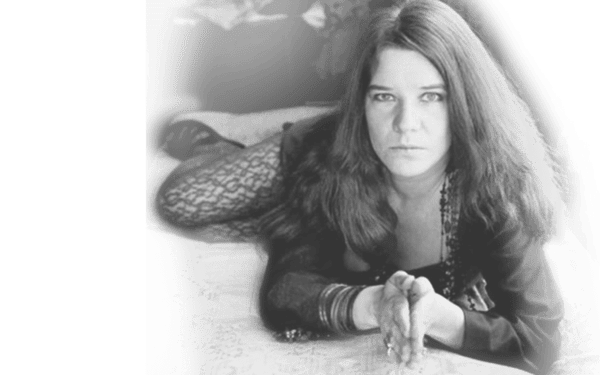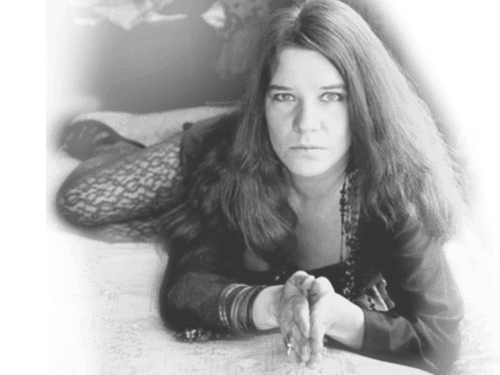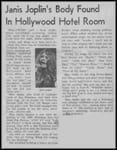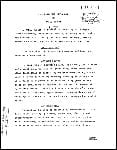Reading Myra Friedman’s rich and richly observed biography, one is astonished to remind oneself that Janis Joplin’s career – from her assumption into stardom to her last fatal encounter with heroin in October, 1970 – took less than five years. Thus, though she is rendered in this book with all the respect and complexity of attitude owed to a completed life, she was at best merely a figure in potentia. Her death at age 27 did not resolve, but only makes egregiously tactless to ask, all the questions that time must put to an important performing artist.
We do not know, for instance, whether her gift – obviously immense but also crude, untrained, harnessed to so much extra-musical purposes – could have survived the violation to which she subjected it. We do not know whether her public persona could have been placed in fealty to the kind of intelligence needed to sustain it. We do not know if she could ever have effected that one small but necessary separation between private life and work that turns promise into a lasting career. That her suicide by an overdose of heroin (accidental or intentional the word suicide must stand) clangs an irreversible answer to such questions can only make more poignant to her admirers the possibility that she was no more than a moment’s enthusiasm.
Nor is the terrible brevity of her life a unique phenomenon in the annals of American show business. We have heard many such stories before – stories of displaced young girls hurtled into stardom, there to confront some nightmare of personality that could not or would not be borne. In the history of Hollywood alone, there would by now have to be a whole chapter devoted just to youthful suicide by drugs.
Having said all this, however, we find that the problem of Janis Joplin does not rest. For if Janis dead tells us nothing more than that there are limits to the liberties one can take with the gift of life, Janis alive – singing and making what one’s grandmother would have called making a spectacle of herself – was proclaimed by a whole generation in our midst to represent their best and deepest impulses. Her audience, professing to be driven to erotic frenzy by her performance, tore apart many a concert hall and called her Earth Mother. She was for them, so they said, the very embodiment of funky, honest feeling, of their new-found refusal of repression, of the end to social sham being made for once and for all by their new culture.
Yet all the while – as Myra Friedman so unblinkingly records – she was actually a person in the process of killing herself. The Earth Mother was no more than the dearest daughter to the Angel of Death. In this startling gap between ideology and reality there lies a special promise: to know who Janis Joplin was is to know a good deal, if not indeed everything that matters, about the epidemic of antic despair that carried off so many of our children in the late 1960’s.
Myra Friedman makes no such direct promise, of course, but she is clearly very much aware that the story she has to tell carries a weight of reference beyond her immediate subject. As careful and as painstakingly as she is in reconstructing the details of Janis’s life – and how glaringly magnified do all those standard banalities of adolescence become in the light of the knowledge that those years were not the beginning but after all the middle ones! – the real ballast of the book lies elsewhere. In passages about the life of Haight-Ashbury, about the society of rock groups in various stations on the way up and down, about concerts and scenes in bars – to which the author was herself, often a witness – “Buried Alive” is given over to the evocation of the hasty triumphs and steady lurking chaos that together comprised the aura within which Janis lived and took her meaning as a figure and died.
Miss Friedman was for three years in charge of Janis Joplin’s press relations, which, given her client’s penchant for rubbing the3 world’s nose in her gaucherie and then recoiling in hysteria from the consequences, must frequently have been a thankless job. She was also her friend – perhaps, it is hard not to think by the ned of this sorry tale of both public and private encouragement to self-destruction, one of her only friends. In that sense, “Buried Alive” is very much an inside book, part memoir, in fact. But contrary to our natural and repeatedly confirmed expectations of books about famous by former press agents – or friends – and written with that most embarrassing obsequious intention to aggress, simultaneously bragging and maligning – the author’s role here is merely that one of whose personal experience has deepened her authority to speak and to judge the assertions of others. If her detachment fails her at times, giving a somewhat overwrought quality to the narrative, her intelligence never does.
The story that Miss Friedman tells is more than anything else the history of an addictions – to heroin and, as Miss Friedman believes, to alcohol, and to some curious substance of the soul produced in the interval between degradation and penitence. The rest of it is there, of course, the whole complement of stardom: concerts, recordings, the sudden flush of money, lovers male and female, friends old and new, enemies, hangers-on, freeloaders; and the author, with an eye that is both cold and compassionate – the definition of kindness – enables us to see these things as they were, shrinking neither from the high spirits nor the ugliness.
But that which the authority of friendship has decreed to be the main motive force of this book is a simple question, a friend’s question and yet surely the hardest of all questions for a friend to answer, namely, why did she have to go and do it? Miss Friedman calls upon some of the traditional resources available for facing such a question, psychoanalysis and sociology, but sparingly. She refrains altogether from those versions of an answer with which the market of easy sentiment was so quickly glutted: Janis was a seeress, taken by a fiery carriage to her proper heavenly rest; Janis was the victim of a society too mean an ugly to allow the survival of one who so boldly flew in its face. And in her careful, non-judging reconstruction she uncovers for us instead what we recognize immediately as the truth: This Janis is not a wild and reckless woman but an incorrigible child, who cannot discipline herself and so cannot in the means to stay alive.
It is a sad story, a terrible story, but also a profoundly infuriating one. The heroine was someone, it comes to seem, willing to hand full responsibility for herself to any passing taker. If and when no hand was available to give her support, why then she would simply be content to fall, and to fall low. One finishes reading the description of a party at which she was to perform at the behest of the Hell’s Angels – and from which she emerges, after an unspeakable scene of degradation, with a helpless whine – feeling that one would have been driven to throttle her on the spot. If she was badly exploited by so many of those who surrounded her, she was also someone who enraged without let or hindrance in the cruelest possible form of exploitation, pressing upon those who cared about her demand that she be kept alive and happy.
In showing us all this – though without herself drawing the same conclusions from it – Miss Friedman makes it possible to understand not only Janis but the far more important issue of the huge and heated response to her. she has, in other words, written a truly serious and valuable, and a genuinely interesting book. To write seriously and truly interestingly on an aspect of popular culture is a thing rarely achieved, a sport between the mostly dull-minded socializing on the one hand and the callow show-biz tittle-tattling on the other, which together make up most of our literature on the subject. And that we should have such a book about that special enclave of the popular culture called, collectively, “rock” – so encased by now in the hardening of legend and the small conceits of manner – is all the more extraordinary.
Far more in keeping with current notions of publishing the dead, I suppose, is a book called “Going Down With Janis.” Published (or perhaps a better word would be “concocted”) by Lyle Stuart and written, to told to the author, by one Peggy Caserta, “Going Down With Janis” is all that its name implies: a blow-by-blow account of Miss Caserta’s lesbian affair with the great and famous Janis Joplin, whom she knew “when” and whom she never ceased to serve, either with her sexual blandishments or her musical advice. This book proves that one can combine the obsequious presumption to which I referred earlier with straight, standard, assembly-line pornography. Its one revelation, although an unwitting one – and as if we didn’t know – is that sex and heroin do not mix.





